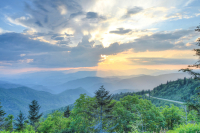Conservation groups plead for red wolf program to stay
 Petitions bearing nearly half a million signatures urging protection of the endangered red wolf made their way to the U.S. Fish and Wildlife Service last week, about one year after the USFWS announced it would suspend a program reintroducing red wolves to the wild.
Petitions bearing nearly half a million signatures urging protection of the endangered red wolf made their way to the U.S. Fish and Wildlife Service last week, about one year after the USFWS announced it would suspend a program reintroducing red wolves to the wild.
Beyond the river: Fly fishing camp builds confident, conservation-minded kids
 Rods, reels, and wader-clad teenagers dotted Big East Fork’s meander to Lake Logan through the warm summer mornings last week, a picture of mountain tranquility framed between green-shrouded banks backlit by the mountain-bordered reservoir downstream.
Rods, reels, and wader-clad teenagers dotted Big East Fork’s meander to Lake Logan through the warm summer mornings last week, a picture of mountain tranquility framed between green-shrouded banks backlit by the mountain-bordered reservoir downstream.
“It’s pretty relaxing,” said Gabby Dilemme, 14, of Brevard. The rod she grasped was her own, an instrument she’s used before when fishing with friends. But at Rivercourse, the annual four-day fly fishing and conservation camp organized by N.C. Trout Unlimited, she was hoping to dig a little deeper into the sport.
Group forms to support Pisgah District
 When John Cottingham, then working as — in his words — a “stuffy, corporate lawyer,” walked into the Pisgah District Ranger Office to drop off a donation, he was surprised to learn that there actually wasn’t a way for the Pisgah National Forest to accept donations toward projects.
When John Cottingham, then working as — in his words — a “stuffy, corporate lawyer,” walked into the Pisgah District Ranger Office to drop off a donation, he was surprised to learn that there actually wasn’t a way for the Pisgah National Forest to accept donations toward projects.
Nearly 50 acres conserved along national forest boundary
 A purchase of 48 acres adjacent to the Pisgah National Forest and the Highlands of Roan by the Southern Appalachian Highlands Conservancy saved the tract from development.
A purchase of 48 acres adjacent to the Pisgah National Forest and the Highlands of Roan by the Southern Appalachian Highlands Conservancy saved the tract from development.
Plateau land trust conserves record number of acres
 With more than 400 acres of land conserved through purchase and conservation easements in 2015, the Highlands-Cashiers Land Trust is celebrating a record year of land protection.
With more than 400 acres of land conserved through purchase and conservation easements in 2015, the Highlands-Cashiers Land Trust is celebrating a record year of land protection.
Reducing their footprint: Smokies unveils new energy-efficient equipment
 The Great Smoky Mountains National Park marked a milestone last week with the unveiling of 10 new pieces of equipment to make transportation in the park more energy-efficient.
The Great Smoky Mountains National Park marked a milestone last week with the unveiling of 10 new pieces of equipment to make transportation in the park more energy-efficient.
A project four years in the making, the new purchases — made using a $239,000 grant — are just the first phase in a three-year plan to reduce emissions in the park.
More than a walk: Conservation, tourism groups expect A.T. onslaught following movie release
 Bill Bryson and Steven Katz didn’t really know what they were getting into when they began their Appalachian Trail journey, recounted in the newly released movie “A Walk in the Woods.” From the moment Katz shows up for the adventure — limping, overweight and prone to seizures — to the time an attempt at traversing a stream sends both men flailing in the water, ineptitude is part of the comedy.
Bill Bryson and Steven Katz didn’t really know what they were getting into when they began their Appalachian Trail journey, recounted in the newly released movie “A Walk in the Woods.” From the moment Katz shows up for the adventure — limping, overweight and prone to seizures — to the time an attempt at traversing a stream sends both men flailing in the water, ineptitude is part of the comedy.
But conservation and tourism organizations along the AT are hoping they won’t find themselves similarly unprepared when thru-hiking season starts up this spring. Featuring stars such as Robert Redford, Nick Nolte, Emma Thompson and Nick Offerman, the movie is expected to appeal to a wide audience, putting the Appalachian Trail at the forefront of many minds.
Behind the wheel with Paul Carlson: a two-hour tour of the Little Tennessee
As Paul Carlson tooled out of downtown Franklin, houses faded into rolling hayfields, and the Little Tennessee River soon took up its flank position along the edge of N.C. 28.
Changing attitudes: Carlson reshaped ideas about conservation
 History will no doubt remember Paul Carlson as one of the great visionaries of our time in Western North Carolina. As the founder and long time director of the Land Trust for the Little Tennessee retires from his leadership role, we pause to reflect on the contributions he’s made.
History will no doubt remember Paul Carlson as one of the great visionaries of our time in Western North Carolina. As the founder and long time director of the Land Trust for the Little Tennessee retires from his leadership role, we pause to reflect on the contributions he’s made.
SEE ALSO: Behind the wheel with Paul Carlson: a two-hour tour of the Little Tennessee
Few men can claim a legacy in the Southern Appalachians as deep or long-lasting as Paul Carlson’s
Couple conserves private tract in Jackson
 A new conservation agreement finalized by the Land Trust for the Little Tennessee will protect 104 acres in Cullowhee from development, preserving it for wildlife, small-scale agriculture and timber management.
A new conservation agreement finalized by the Land Trust for the Little Tennessee will protect 104 acres in Cullowhee from development, preserving it for wildlife, small-scale agriculture and timber management.





